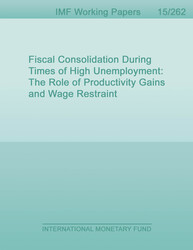
Fiscal Consolidation During Times of High Unemployment : The Role of Productivity Gains and Wage Restraint
This paper studies the Swedish fiscal consolidation episode of the 1990s through the lens of a small open economy model with distortionary taxation and unemployment. We argue that the simultaneous reduction in the fiscal deficit and unemployment rate in this episode stems from two factors: (i) high growth rates of total factor productivity (TFP), experienced after the implementation of structural reforms; and (ii) a sustained wage restraint that occurred during the 1990s. The model simulations show that economic growth, accounted for mostly by TFP gains, improved the fiscal balance by 8 percentage points of GDP through an expansion of the tax base and fiscal revenues. Moreover, the combination of stable wages and higher TFP boosted net exports and led to a reduction in the unemployment rate. A counterfactual simulation assuming stagnant TFP shows that fiscal consolidation measures alone would have generated a double-digit unemployment rate without eliminating the fiscal deficit.
Publication date: December 2015
ISBN: 9781513501192
$18.00
Add to Cart by clicking price of the language and format you'd like to purchase
Available Languages and Formats
| English |
Prices in red indicate formats that are not yet available but are forthcoming.
Topics covered in this book
This title contains information about the following subjects.
Click on a subject if you would like to see other titles with the same subjects.
Economics- Macroeconomics , Economics / General , International - Economics , Fiscal Consolidation , Search Models of Unemployment , Small Open Economy
Summary
Copyright © 2010 - 2024
Powered by:
AIDC



